Zoom
Trash

Windows Server 2012 Upgrade. January 30, 2013By Michael Gabriel Sumastre If recent surveys cited by tech blogs and mainstream media are to be believed, then Windows Server 2012 is a win.
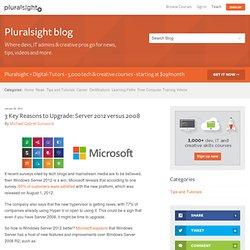
Microsoft reveals that according to one survey, 65% of customers were satisfied with the new platform, which was released on August 1, 2012. The company also says that the new hypervisor is getting raves, with 77% of companies already using Hyper-V or open to using it. This could be a sign that even if you have Server 2008, it might be time to upgrade. So how is Windows Server 2012 better? 1. The security of a multi-tenant environment is one of the biggest concerns of cloud users today. Microsoft’s Windows Server 2008 provided some solutions to that problem by allowing you to isolate two virtual machines through server virtualization. In Windows Server 2012, server virtualization not only covers the machines but also the network layer of your data center.
Private Virtual Local Area Network or PVLAN Hyper-V Extensible Switch. 2. 3. Week 2 Topology. Powerful thin clients may be alternative to PCs. Thin clients introduced this week by Dell and Hewlett-Packard have faster processor than existing thin clients as well as high-definition graphics capabilities, so they could be alternatives to traditional PCs as computing continues moving to the cloud.
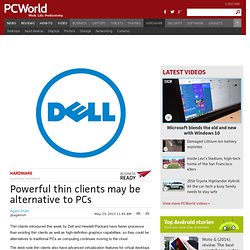
The desk-side thin clients also have advanced virtualization features for virtual desktops to host multiple applications in one session. They were announced at the Citrix Synergy conference in Los Angeles. Dell introduced its first quad-core thin clients called the Wyse D90Q7 and Z90Q7, and also its first dual-core thin client, the Xenith Pro 2. HP upgraded its TM40 thin client to run Advanced Micro Devices’ A-series processors code-named Richland, which are an upgrade from Intel’s third-generation Celeron processors. The thin clients are optimized to work with Citrix’s virtualization stack, which includes Xen hypervisors and server and client software. The latest thin clients are PCs with network connectivity but no local storage. 200 Series Switches Data Sheet. Build a Powerful, Easy-to-Use Basic Business Network at an Affordable Price The key to succeeding in today's competitive business environment is investing resources wisely - knowing how to separate the essential from the extraneous and get the most value for your dollar.
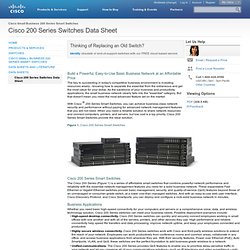
As the backbone of your business and productivity applications, the small business network clearly falls into the "essential" category. But that doesn't mean you need the most advanced feature set on the market. With Cisco ® 200 Series Smart Switches, you can achieve business-class network security and performance without paying for advanced network management features that you will not need. When you need a reliable solution to share network resources and connect computers, printers, and servers, but low cost is a top priority, Cisco 200 Series Smart Switches provide the ideal solution. Figure 1. Cisco 200 Series Smart Switches. Thoughts on virtualizing of server running PDC, DNS, DHCP, exchange server, and website - Virtualization - Business Computing.
Johnny-mac said: It sounds like you're planning on using a desktop version of VMware (Workstation or player).
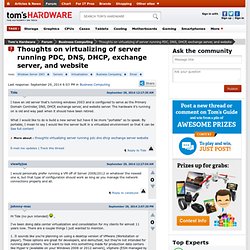
These options are great for developers, and demo/test, but they're not intended for running data centers. Yes. I'm thinking about using the desktop version of VMware Workstation. (the server I'm using now is -or rather was- a desktop machine that's been running solid 24/7 for nearly 12 years! You'll want to look into something made for production data centers like Hyper-V (available on your Windows 2008 or 2012 servers), vSphere (ESXi managed by vCenter Server), or Xen Server. I probably will have to look into ESXi or Xen Server at a future point... maybe that'll be the next step but again, at this point. In order to get the most out of server virtualization, you're going to need a farm of 2-3 host servers, and shared storage. Lastly, If you do go the virtual route, suggest breaking out your workloads into separate virtual servers. Regards, Tide. Computer Security Publications - NIST Special Publications (SPs)
NIST uses three NIST Special Publication subseries to publish computer/cyber/information security and guidelines, recommendations and reference materials: SP 800, Computer Security (December 1990-present): NIST's primary mode of publishing computer/cyber/information security guidelines, recommendations and reference materials (SP 800s are also searchable in the NIST Library Catalog); SP 1800, NIST Cybersecurity Practice Guides (2015-present): A new subseries created to complement the SP 800s; targets specific cybersecurity challenges in the public and private sectors; practical, user-friendly guides to facilitate adoption of standards-based approaches to cybersecurity; SP 500, Computer Systems Technology (January 1977-present): A general IT subseries used more broadly by NIST's Information Technology Laboratory (ITL), this page lists selected SP 500s related to NIST's computer security efforts.
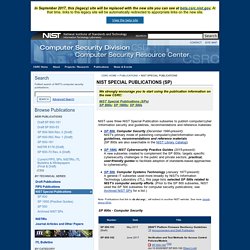
Note: Publications that link to dx.doi.org/... will redirect to another NIST website.